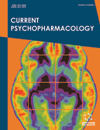- Home
- A-Z Publications
- Current Psychopharmacology
- Previous Issues
- Volume 5, Issue 2, 2016
Current Psychopharmacology - Volume 5, Issue 2, 2016
Volume 5, Issue 2, 2016
-
-
Translational Pharmacology of a Putative Measure of Motor Impulsivity in Larval Zebrafish
More LessAuthors: Matthew O. Parker and Caroline H. BrennanBackground: Impulsivity is poorly planned, premature or inap- propriate behaviour, and deficits in impulse control are linked to a number of neuropsychiatric disorders. There are a number of theories relating to the neural basis of impulsivity, but the precise molecular mechanisms of im- pulse control are not clearly understood. Motor impulsivity has been ob- served in adult zebrafish, but in order to increase throughput it Read More
-
-
-
Zebrafish as a Model Organism to Study Melatonin Mechanisms and Treatments
More LessAuthors: Maura Southwell and Scott McRobertBackground: Melatonin is an evolutionarily highly conserved molecule. In humans, exogenous melatonin has been shown to entrain cir- cadian rhythms to light dark cycles and act as an antioxidant. Many com- plex brain disorders, such as autism and Alzheimer's disease, are associated with abnormal melatonin production or melatonin metabolism. Exogenous melatonin may serve as a potential treatment to improve sleeping Read More
-
-
-
A Review of Monoaminergic Neuropsychopharmacology in Zebrafish, 6 Years Later: Towards Paradoxes and their Solution
More LessAuthors: Caio Maximino, Bruna P. Costa and Monica G. LimaPurpose: To review current findings on the neuro- and psycho- pharmacology of monoamine neurotransmitters in zebrafish, as well as its consequences for psychopharmacology and evolutionary neuroscience. Methods: A narrative review of the relevant papers known to the authors was conducted. Results: Monoamine neurotransmitters are major neuromodulatory mecha- nisms in the vertebrate brain, associated wi Read More
-
-
-
Zebrafish Models to Study Fear and Anxiety
More LessAuthors: Adam D. Collier and David J. EchevarriaBackground: Psychiatric disorders related to fear and anxiety are common throughout the world, and their neurobiological mechanisms are not fully understood. Studying animal models has been a common strategy to probe mechanisms of normal and pathological brain functioning. Experimental paradigms originally developed with mammalian models, such as predator exposure, fear learning, exposure to predator-r Read More
-
-
-
Relevance of Test- and Subject-Related Factors on Inhibitory Avoidance (Performance) of Zebrafish for Psychopharmacology Studies
More LessAuthors: Remy Manuel, Marnix Gorissen and Ruud van den BosBackground: The inhibitory (or passive) avoidance paradigm is widely used to assess the effects of drugs on emotion, learning and memory in rodents. The zebrafish is gaining more and more popularity as an animal model in, among others, psychopharmacological research. In zebrafish, inhibitory avoidance is also used as assay to assess the effects of drugs and other treatments on fear-associated learning. The inhibitory Read More
-
-
-
The Novel Tank Test: Handling Stress and the Context Specific Psychopharmacology of Anxiety
More LessAuthors: Steven Tran and Robert T. GerlaiBackground. The zebrafish has become a popular animal model for behavioral pharmacology. One of the greatest advantages of the zebrafish is its amenability for high throughput screens to identify anxiety altering compounds. The novel tank diving test is arguably one of the most commonly utilized behavioral tests for quantifying anxiety-like behavioral responses in zebrafish. However, a number of context-dependent anxiety- Read More
-
-
-
Pharmacological Manipulation of Shoaling Behavior in Zebrafish
More LessAuthors: Soaleha Shams and Robert T. GerlaiBackground: The zebrafish has been a favorite of developmental biologists and geneticists for decades, however, recently, it has gained popularity among behavior researchers too. The reason for the popularity of this species is that while it is a simple vertebrate, it possesses numerous features that make it translationally relevant. Objective: Social interaction is an essential component of human as well as zebrafish behavior; yet, Read More
-
-
-
Zebrafish as an Animal Model to Study Epileptic Seizures and Epileptic Syndromes
More LessBackground: Epilepsy is a chronic disorder of the brain. Globally, an estimated 2.4 million people are diagnosed with epilepsy each year. Recent studies have shown that 70% of epileptic patients can be successfully treated with anti-epileptic drugs. Unfortunately, 30% of the patients still suffer from intractable epilepsy, a problem that represents a difficult scientific challenge. Crucial genetic research and high throughput drug sc Read More
-
-
-
Zebrafish as a Platform for Studies on Seizures and Epilepsy
More LessAuthors: Rosane S. da Silva, Carla D. Bonan and Monica R.M. ViannaBackground: In vivo studies are crucial for the identification of pathogenic cellular and molecular mechanisms. Animal models are especially relevant due to their systems' integrity and evaluation of multiple translational parameters. Objective: This review presents a general panorama of the pharmacological and genetic seizure models using this species as a platform for disease modeling and accelerated drug discovery. Read More
-
Most Read This Month
Article
content/journals/cpsp
Journal
10
5
false
en


